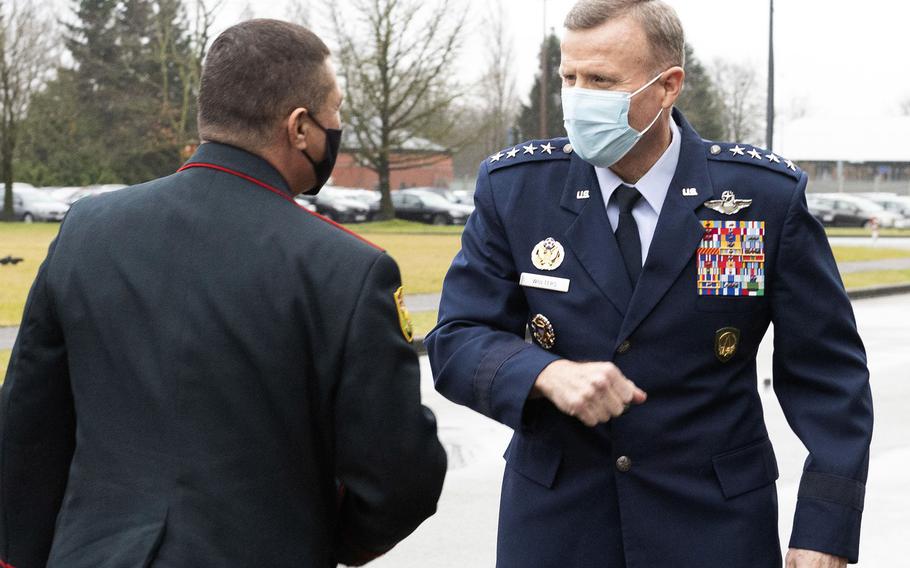
U.S. European Command's Gen. Tod D. Wolters welcomes Moldovan defense chief Brig. Gen. Igor Gorgan to Supreme Headquarters Allied Powers Europe at Mons, Belgium, Jan. 28, 2021. Wolters said Wednesday, Feb. 3, that previous administration's proposal to move 12,000 service members out of Germany will be reexamined. ( Ross Fernie/NATO)
STUTTGART, Germany — The U.S. is no longer actively preparing to move nearly 12,000 troops out of Germany, putting an initiative proposed by the Trump administration on ice while the Pentagon reviews it, the top American general in Europe said Wednesday.
The plan, which called for relocating U.S. European Command from Stuttgart to Belgium, returning the Vilseck, Germany-based 2nd Cavalry Regiment to the U.S. and a host of other moves, would have been one of the largest repositioning of forces in Europe in decades.
“At this very moment, every single one of those options, they are all on hold. They will all be reexamined from cradle to grave,” U.S. European Command’s Gen. Tod Wolters told reporters.
Defense Secretary Lloyd Austin has begun “a very thorough review” of the proposed drawdown, which was announced in July by his predecessor, Mark Esper, Wolters said.
Then-president Donald Trump had ordered the Pentagon to come up with a plan to reduce the U.S. military presence in Germany, saying that there were too many American troops in the country, which he repeatedly said was not investing enough in its own defense.
At one point, Trump said Germany was “delinquent” on its financial contributions to NATO. He also said the country was financially benefitting from having U.S. forces in the country.
Around 34,000 troops are stationed in Germany, with many of them focused on missions in other parts of Europe, such as enhancing security along NATO’s eastern flank, or extending the U.S. military’s reach into the Middle East and Africa.
When the proposed drawdown was first announced, Esper and Wolters said taking troops out of Germany and moving them elsewhere would enhance security on the Continent.
But critics of the plan, including a large, bipartisan group of U.S. lawmakers, questioned how reducing forces would enhance efforts to deter Russian aggression on the Continent, a main focus of the U.S.-led NATO alliance since the 2014 annexation of the Crimean Peninsula and the invasion of eastern Ukraine.
The possibility of withdrawing thousands of American troops shook the many towns and cities in Germany that house them.
Hans-Martin Schertl, the mayor of Vilseck in Bavaria, last summer called the proposed drawdown, which would have pulled 4,500 troops out the town of just 6,400 residents, a “bitter loss.” Vilseck would need state and federal government support to survive, he said.
Stuttgart Lord Mayor Fritz Kuhn in July called the proposed troop cuts “punitive action against an ally” that “upended decades of close cooperation” between Germany and the U.S. But, he said, he was hopeful that the plan would be reversed and that the bases — and U.S. troops — would stay put.
Wolters did not say when Austin was expected to wrap up his review. But when it is completed, he said, “we will go back to the drawing board.”
Stars and Stripes reporter Marcus Kloeckner contributed to this report.
vandiver.john@stripes.com Twitter: @john_vandiver